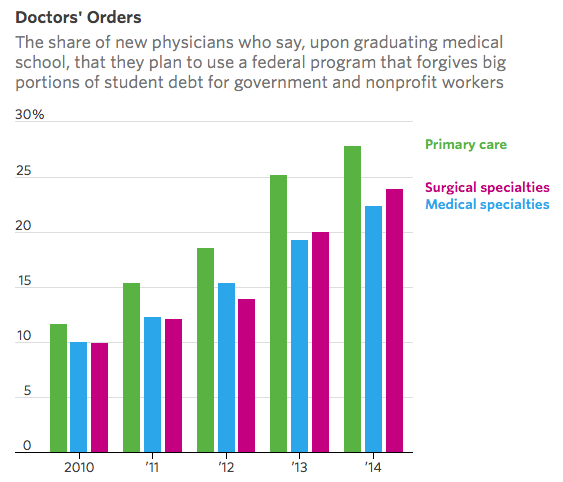- October 1,2016 | ISSN 1940-6967
- The National Association Of Medical Doctors
Featured Sponsors
Government On Track To Forgive Up To $131,000 Each In Student Debt For Thousands Of Doctors
By Josh Mitchell
Many highly paid doctors are poised to get a very large windfall from the federal government.
A program designed to ease the student-debt burden of teachers, public defenders and other modestly paid workers in the public sector is also set to help thousands of physicians, many of whom work for nonprofit hospitals. On average, recent medical-school graduates who enroll in the program will have roughly $131,000 in their student debt forgiven.
The peer-reviewed paper shows how new physicians are increasingly enrolling in a program known as Public Service Loan Forgiveness.
File this under “unintended consequences of congressional legislation.” When Congress created the program in 2007, the intent was to encourage young workers to seek government and nonprofit jobs that pay far less than what they’d get in the private sector. Think public defenders, teachers, librarians and, yes, a small share of primary-care physicians who forgo lucrative salaries to work in underserved areas. (Members of Congress are excluded, before you ask.)
Payments are kept low under the program. Workers make 120 monthly payments—or 10 years’ worth, though the payments don’t have to be consecutive—toward their student loans. The payments are capped at 10% of discretionary income, defined as a borrower’s adjusted gross income minus 150% the federal poverty level. Any balance remaining after the 120 payments is forgiven, tax-free.

The program applies to just about anyone who works for a nonprofit, regardless of salary. An increasing share of physicians—including highly paid specialists like surgeons–are eligible as nonprofits buy up hospitals and private practices. Three-quarters of hospitals are either nonprofit or owned by the government.
Physicians are particularly well positioned for big payouts. The typical borrower owed a median $162,000 upon leaving medical school in 2012.
And they don’t earn big salaries right away. Doctors typically earn between $50,000 and $60,000 in the first three to eight years out of school as they complete training, known as “residency.” Thus, the amount they pay under income-based repayment will be low, at least through training. Their salaries skyrocket, to $180,000 and above, once out of training.
Four researchers–Ari Friedman of the University of Pennsylvania, along with Justin Grischkan, E. Ray Dorsey and Benjamin George of the University of Rochester–looked at annual surveys of soon-to-be medical school graduates to determine the average loan forgiveness new graduates will eventually receive.
They started with an annual survey of all graduating medical-school students across the U.S. The survey asks them to list, among other things, their intended specialty and whether they planned to use the debt-forgiveness program. The share planning to get forgiveness has risen steadily. Overall, 25% of doctors who graduated from medical school in 2014 said they intended to use the program, up from 10.6% in 2010. Doctors of all types intend to use it, including highly paid surgeons.
The researchers looked at 2,416 borrowers who graduated from medical school in 2014 and determined that, on average, each would get roughly $131,000 forgiven, tax-free, in 2024. That comes out to a total of $316 million. (The figures use a discount rate of 6%. Without the rate, the average forgiveness would be about $200,000 in 2024 dollars.)
The taxpayer tab will likely grow for subsequent classes as awareness of the program increases.
The study doesn’t make clear how much these doctors, on average, will have paid toward their loans by the time they get forgiveness. The researchers cite an estimate suggesting many doctors will have paid sums in the low six figures, though estimates vary depending on salary and how much they owe.
The Obama administration is aware of potential for big payouts for highly paid doctors. The White House, as part of its annual budget proposals, has twice proposed capping loan forgiveness at $57,500. The proposal would need to be approved by Congress, which has not acted on it.
Articles in this issue:
- The Perils Of Being Your Own Doctor
- Government On Track To Forgive Up To $131,000 Each In Student Debt For Thousands Of Doctors
- Colorado: Kids' ER Visits For Marijuana Have Surged Since Legalization
- The Paradox Of Radiation
- Depressed? Your Therapist Might Prescribe Ketamine Soon
- Seven Deadliest Emergency General Surgeries
- Top US Hospital: 50% Of Surgeries Have Drug Related Errors
Top Physician Opportunities
Journal of Medicine Sign Up
Get the Journal of Medicine delivered to your inbox.
In This Issue
- The Perils Of Being Your Own Doctor
- Government On Track To Forgive Up To $131,000 Each In Student Debt For Thousands Of Doctors
- Colorado: Kids' ER Visits For Marijuana Have Surged Since Legalization
- The Paradox Of Radiation
- Depressed? Your Therapist Might Prescribe Ketamine Soon
- Seven Deadliest Emergency General Surgeries
- Top US Hospital: 50% Of Surgeries Have Drug Related Errors
Masthead
-
Editor-in Chief:
Theodore Massey
Editorial Staff:
Roberta Ness
Bob Thompson
Arthur Staturo
Renaldo Aturo
Michael Friendly
Creative Oversight:Design Director:
Agency San Francisco, Inc.
Design Firm:
Agency San Francisco, Inc.Contributors:
Sandra Bowing
Toby Garcia
Irene Suvlano
Willam Crawley
Jon Young
Leave a Comment
Please keep in mind that all comments are moderated. Please do not use a spam keyword or a domain as your name, or else it will be deleted. Let's have a personal and meaningful conversation instead. Thanks for your comments!















*This site is protected by reCAPTCHA and the Google Privacy Policy and Terms of Service apply.